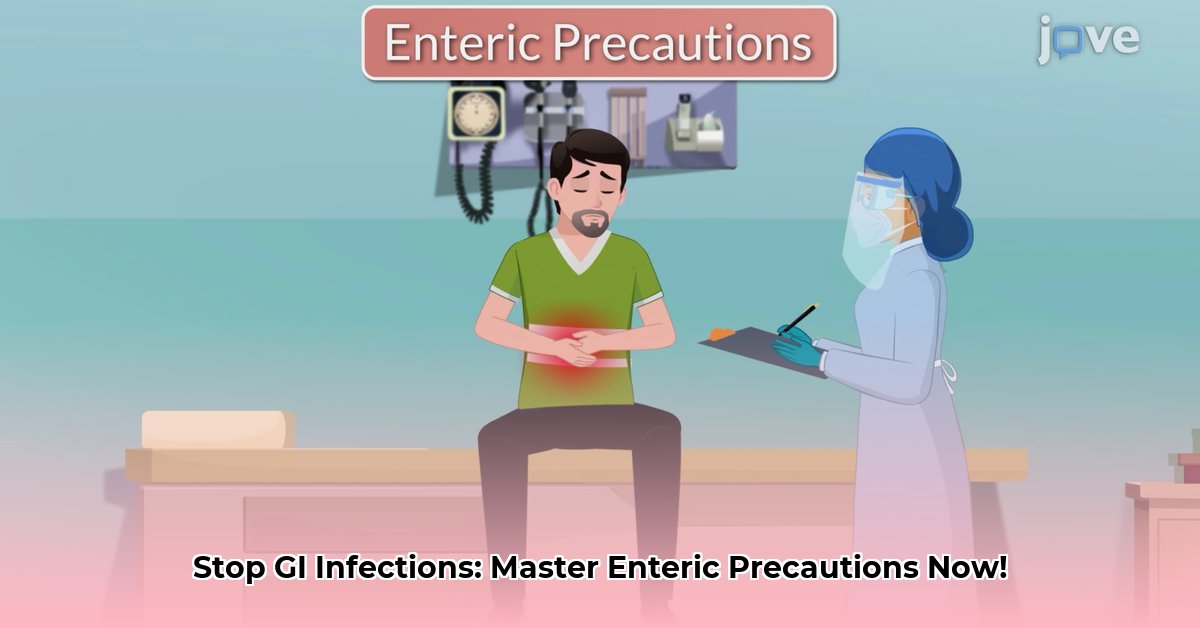Let’s face it, stomach bugs within healthcare environments are a serious issue. They exacerbate patient illness and incur substantial costs to manage. This guide offers a practical roadmap to effectively curb the spread of these infections. We’ll demystify enteric precautions, clarify the efficacy of hand sanitizers versus soap and water, and furnish a straightforward, step-by-step plan to bolster workplace safety for everyone. Furthermore, we’ll address strategies for ensuring protocol adherence and keeping your prevention plan current.
Enteric Precautions: Your Guide to Preventing GI Infections
Protecting ourselves and our loved ones from gastrointestinal infections is paramount, especially within healthcare settings. Enteric precautions serve as the primary defense against these infections, which can spread rapidly. This goes beyond basic hygiene. It’s a holistic approach designed to safeguard everyone’s health and well-being. Are you ready to implement a comprehensive infection control strategy to protect vulnerable populations?
Understanding Enteric Precautions: Building a Germ-Free Fortress
Enteric precautions comprise a series of straightforward yet impactful infection control measures. Envision it as a fortress, safeguarding vulnerable patients (and healthcare workers) from pathogens that can cause diarrhea. The emphasis is on minimizing the transmission of these infections by limiting exposure to potentially hazardous bodily fluids and surfaces. This strategy drastically reduces the probability of those sneaky germs spreading and causing illness.
These precautions are crucially important in hospitals and clinics, where many individuals are already immunocompromised, making them more susceptible to infections.
The Key Players in Enteric Precautions: A Simple Breakdown
Effective enteric precautions rely on several key actions, working together to keep those germs at bay:
-
Hand Hygiene: The Unsung Hero: Frequent and thorough handwashing represents the most effective means of preventing infection spread. This includes washing before and after patient contact, after glove removal, and anytime your hands may be contaminated. Lather with soap and water for at least 20 seconds, or use an alcohol-based hand sanitizer if soap and water aren’t accessible. Remember, for Clostridioides difficile (C. diff) infections, soap and water are preferred over alcohol-based sanitizers. It’s simple and incredibly effective!
-
Personal Protective Equipment (PPE): Your Armor Against Germs: Gloves serve as your primary defense, so wear them anytime you anticipate contact with bodily fluids. Gowns or aprons offer added protection, particularly when there’s a risk of splashes or spills. Eye protection might be required in certain situations (e.g., cleaning up a particularly messy incident). Awareness of appropriate PPE use is vital. Ensure proper donning and doffing techniques to avoid self-contamination.
-
Cleaning and Disinfection: Keeping the Environment Safe: Regular cleaning and disinfection of surfaces and equipment is crucial. This involves thorough cleaning to eliminate visible soil, followed by disinfection with an appropriate agent to kill pathogens and prevent their spread. Pay special attention to high-touch surfaces like door knobs, bed rails, and medical equipment. View it as creating a fresh start for your workspace.
-
Waste Disposal: Proper Disposal of Contaminated Materials: Careful handling of soiled linens, dressings, and other contaminated waste is vital. Dispose of them in accordance with your facility’s guidelines to prevent contamination spread. Use designated, leak-proof containers, and ensure proper labeling. This easy step guarantees a clean environment.
-
Patient Placement and Cohorting (when needed): Protecting Many from One: At times, isolating a patient with infectious diarrhea becomes necessary to avert infection spread. This isn’t always required but delivers a vital measure to protect other patients and staff when needed. When single rooms aren’t available, consider cohorting patients with the same infection.
Who’s on the Team? Everyone Plays a Part
Enteric precautions aren’t solely the responsibility of doctors and nurses. Everyone involved in patient care has an important role:
| Stakeholder Group | Their Role in Enteric Precautions |
|---|---|
| Healthcare Workers | Following hand hygiene and PPE guidelines precisely; mastering proper cleaning and disinfection techniques. |
| Environmental Services | Maintaining a clean and disinfected environment, adhering to established protocols for waste disposal and linen handling. |
| Hospitals/Clinics | Implementing strong infection control policies; ensuring staff have enough PPE and cleaning supplies. |
| Patients | Practicing good hygiene; reporting any diarrhea symptoms immediately to the healthcare team. |
| Visitors | Adhering to facility guidelines regarding hand hygiene and PPE when visiting patients on enteric precautions. |
| Public Health Officials | Monitoring outbreaks; establishing and enforcing public health guidelines related to enteric precautions. |
The Challenges and How We Overcome Them
While the importance of these precautions is clear, maintaining consistent compliance can be challenging. Time constraints, staffing shortages, inadequate training, and a lack of readily available supplies can affect adherence. The solution? Invest in thorough training, easily accessible resources and supplies, and a workplace culture that prioritizes infection control. Make training interactive and engaging, and provide regular updates on best practices. It requires teamwork!
The Bottom Line: Prevention is Worth the Effort
Enteric precautions aren’t just another task; they’re a crucial investment in patient safety and a cornerstone of infection prevention. It’s about fostering a healthier, safer environment for everyone. By consistently implementing these simple steps, we significantly mitigate the risk of gastrointestinal infections and protect the well-being of our patients and ourselves. Think of it as a mutually beneficial scenario: health for patients and healthcare personnel, along with reduced healthcare costs! It’s a commitment to delivering humane and effective care. Could a more comprehensive approach to enteric precautions significantly reduce healthcare costs? Absolutely, by preventing outbreaks and reducing the need for costly treatments and extended hospital stays.
How to Improve Enteric Precaution Compliance in Healthcare Settings
What are the key strategies for enhancing adherence to enteric precautions, especially in light of the rising threat of antibiotic-resistant organisms?
Key Takeaways:
- Hand hygiene is paramount, with soap and water preferred over alcohol-based rubs for C. difficile (Clostridioides difficile) infection.
- Proper personal protective equipment (PPE) use is crucial.
- Patient isolation significantly reduces transmission risk, particularly for patients with enteric infections.
- Thorough cleaning and disinfection protocols are non-negotiable and include the use of appropriate EPA-registered disinfectants with activity against the target pathogens.
- Education for both healthcare workers and patients is key to fostering a culture of safety.
- Addressing unique challenges posed by specific pathogens is necessary for effective infection control.
- Proactive prevention strategies are more cost-effective than reactive outbreak management.
Understanding the Challenge: Why Compliance Matters
Gastrointestinal infections can spread rapidly, disrupt hospital operations, and threaten patient safety. How to improve enteric precaution compliance in healthcare settings is a question every healthcare professional should be actively addressing. Think of it like this: A single missed step in the chain can compromise the entire system, leading to potential outbreaks and increased healthcare costs. Furthermore, consider the impact on staff morale and the facility’s reputation.
The Foundation: Effective Enteric Precautions
Effective enteric precaution involves a multi-pronged strategy; it’s not a single action but a coordinated effort. Think of it as a fortress with many layers of defense, each crucial in protecting patients and staff.
-
Hand Hygiene: This serves as your front line of defense, and proper handwashing with soap and water is essential, especially against C. difficile spores. Alcohol-based hand rubs (ABHR) have their place, but they’re not effective against all pathogens. Make hand hygiene easily accessible by placing handwashing stations and ABHR dispensers throughout the facility.
-
Personal Protective Equipment (PPE): Gowns and gloves act as your armor. Appropriate PPE selection and use prevent contamination. Understand the specific PPE required for each situation to ensure maximum protection. Provide readily available PPE in various sizes and ensure staff are trained on proper donning and doffing procedures.
-
Patient Isolation: Isolating infected patients is crucial to limit direct contact and contain the spread. Dedicated isolation rooms are ideal for minimizing the risk of transmission. When isolation rooms are limited, prioritize their use for patients with the most highly transmissible infections.
-
Cleaning and Disinfection: Thorough cleaning and proper disinfection of high-touch surfaces are vital, even beyond visibly soiled areas. Remove all traces of pathogens to prevent further spread after a patient is discharged. Use EPA-registered disinfectants according to the manufacturer’s instructions, paying attention to contact time.
Targeting Different Stakeholders
How to improve enteric precaution compliance in healthcare settings requires a team effort. Each role has specific responsibilities to guarantee cohesive and effective infection control practices.
Healthcare Workers: Participate in regular refresher courses to stay updated on best practices, demonstrate consistent hand hygiene, and master correct PPE usage. Report any breaches in protocols immediately to maintain a safe environment. Encourage a “see something, say something” culture.
Infection Control Teams: Develop and regularly review compliance guidelines, using available data to identify weaknesses and tailor education to address these issues. Conduct regular audits and promptly respond to outbreaks to prevent further spread. Implement feedback mechanisms to address staff concerns and suggestions.
Patients and Families: Emphasize the importance of hand hygiene, reporting symptoms promptly, and following all isolation protocols. Educating patients is an investment in effective infection control. Provide educational materials in multiple languages and formats.
Healthcare Administrators: Invest in staff training and provide the necessary resources for infection control. Regularly assess compliance and allocate adequate budget for these measures. What innovative technology could
- Lunch Box That Fits Bento Box Neatly for Daily Use - December 5, 2025
- Japanese Lunch Bag Does Double Duty as Bento Carrier and Tote - December 4, 2025
- Your Perfect Bento Box Bag For Fresh And Tidy Meals - December 2, 2025










